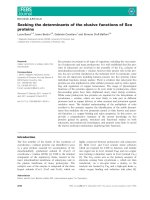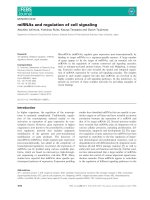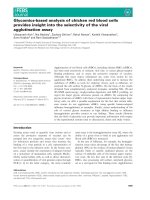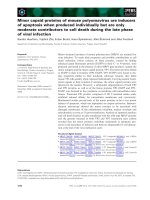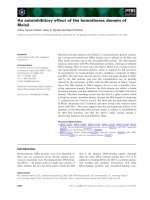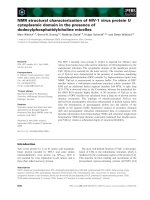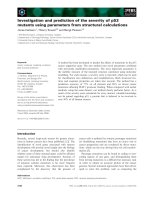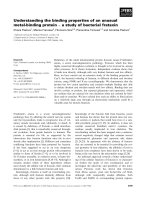Tài liệu Báo cáo khoa học: "Defining the Semantics of Verbal Modifiers in the Domain of Cooking Tasks" pptx
Bạn đang xem bản rút gọn của tài liệu. Xem và tải ngay bản đầy đủ của tài liệu tại đây (635.96 KB, 7 trang )
Defining the Semantics of Verbal Modifiers
in the Domain of Cooking Tasks
Robin F. Karlin
Department of Computer and Information Science
University of Pennsylvania
Philadelphia, PA 19104-6389
Abstract
SEAFACT (Semantic Analysis For the Animation of
Cooking Tasks) is a natural language interface to a
computer-generated animation system operating in
the domain of cooking tasks. SEAFACT allows the
user to specify cooking tasks "using a small subset of
English. The system analyzes English input and pro-
duces a representation of the task which can drive
motion synthesis procedures. Tl~is paper describes
the semantic analysis of verbal
modifiers on
which
the SEAFACT implementation is based.
Introduction
SEAFACT is a natural language interface to
a computer-generated animation system (Karlin,
1988). SEAFACT operates in the domain of cooking
tasks. The domain is limited to a mini-world con-
sisting of a small set of verbs chosen because they
involve rather complex arm movements which will be
interesting to animate. SEAFACT allows the user to
specify tasks in this domain, using a small subset of
English. The system then analyzes the English input
and produces a representation of the task. An intelli-
gent simulation system (Fishwick, 1985,1987), which
is currently being extended, will provide the final link
between the SEAFACT representation and lower level
motion synthesis procedures. The representation con-
sists of a decomposition of verbs into primitive actions
which are semantically interpretable by the motion
synthesis procedures. It also includes default infor-
mation for all knowledge which is not made explicit
in the input, but must be explicit in the animated
output. The representation contains sufficient non-
geometric information needed to schedule task start
and end times, describe concurrent actions, and pro-
vide reach, grasp, and motion goals.
An empirical, linguistic study of recipes was con-
ducted with the goals of delimiting the scope of the
cooking domain, identifying important verbal mod-
ifiers, and defining the semantics of those modifiers.
This paper is concerned primarily with describing the
results of this study and the implementation of some
of the modifiers.
A Linguistic Analysis of Verbal
Modifiers
An empirical study of approximately II0 sentences
from nine cookbooks was carried out. Verbal mod-
ifiers were found to play an essential role in the ex-
pressive power of these sentences. Therefore, in order
to develop a representation for the verbal modifiers,
the study describes and categorizes their occurences
and provides a semantic analysis of each of the cate-
gories. Each of the categories is considered a seman-
tic role in the representation of the natural language
input. Temporal adverbials were found to be partic-
ularly prevalent in recipes because they are needed
to specify temporal information about actions which
is not inherent in the meaning of verbs and their ob-
jects. This paper discusses two categories of temporal
modifiers: duration and repetitions as well as speed
modifiers. Other categories of modifiers which were
analyzed include quantity of the object, end result,
instrument, and force.
Passonnean (1986) and Waltz (1981,1982) are con-
cerned with developing semantic representations ad-
equate for representing adverbial modification. Pas-
sonneau's work shows that to account for tense and
grammatical aspect requires a much more complex
representation of the temporal components of lan-
guage than the one used in SEAFACT. However, she
does not look at as many categories of temporal ad-
verhials, nor does she propose ~specific representa-
tion for them. Waltz (1982) suggests that adverbs
will be represented by the scales in his event shape
diagrams. For example, time adverbials will be tel>-
61
resented by the time scale and quantity adverbials
by the scale for quantity of the verbal objects. This
is similar to the approach taken in SEAFACT. In
SEAFACT scales are replaced by default amounts for
the category in question, for example the duration of
a primitive action.
Aspectual Category of an Event
The aspectual category of an event is relevant because
it affects which types of modifiers (e.g., repetitions,
duration) can co-occur with the event. The analy-
sis of aspect given in Moens (1987) (see also (Moens,
1988)) is adopted here. Moens and Steedman iden-
tify temporal/aspectual types following Vendler, but
introduce new terminology. They apply these types
to entire sentences, analyzed in their global context.
Moens and Steedman's events are classified as culmi-
nated processes, culminations, points, or processes.
The majority of events in the cooking domain are
calmina~ed procesaes. A culminated process is
a state of affairs that also extends in time
but that does have a particular culmination
associated with it at which a change
of
state
takes place. (Moens, 1987, p. 1)
Each process in cooking must have a culmination be-
cause any cooking task involves a finite sequence of
steps, whose goal is to bring about a state change. An
important point about verbal modifiers in the cook-
ing domain, revealed in this study, is that many of
them are concerned with characterizing the culmina-
tion points of processes. In many cases a verb and
object alone do not specify a clear culmination point.
For example, the command beat the crpam does
not contain information about the desired culmina-
tion of the process, that is, when to stop the beating.
Some sort of verbal modifier such as for 10 minutes
or just until it forms peaks is necessary to specify
the culmination of the process.
Another aspectual type is a
culmination. A culmi-
nation is
an event which the speaker views as accom-
panied by a transition to a new state of the
world. This new state we will refer to as the
"consequent state" of the event. (Moens,
1987, p. 1)
Culminations, such as cover the pot, are not ex-
tended in time as are processes and culminated pro-
CesseS.
In addition to the sentential aspect discussed
above, the SEAFACT implementation identifies the
lexical aspect of the verb. The lexical aspect refers
to the aspectual category which can be ascribed
to
a verb considered outside of an utterance. For ex-
ample, the lexical aspect of the verb stir is a process.
However, the sentential aspect of the sentence s~ir the
soap for S minates is a culminated process. The im-
plementation checks that the sentential aspect of each
input sentence containing a process verb is a culmi-
nated process. That is, there must be some verbal
modifier which coerces the process into a culminated
process. If this is not the case, as in the sentence
stir the soap, then the input is rejected since it would
specify an animation without an ending time. The
lexical aspect is also used in the analysis of speed
modifiers, as discussed below.
The Number of Repetitions of the Ac-
tion
Any expreesion which includes an endpoint, and
therefore belongs to one Of the aspectual cla-qses of
points, culminations, or culminated processes can be
described as having a number of discrete repetitions.
When a culminated process is described as having a
number of repetitions, it is the entire process which is
repeated. Process type events cannot have a number
of repetitions associated with them since they do not
include the notion of an end point. The number of
repetitions of the event can be specified as a cardinal
number, as a frequency, or indirectly as a result of
the object of the verb being plural, having multiple
parts, or being a r~ term.
Cardln~! Count Adverbials
Cardinal count adverbials (Mourelatos, 1981, p. 205)
specify an exact number of repetitions of the event.
(1) baste tw/ce during the cooking period
(Rombauer, 1931, p. 350)
Notice that in the case of certain verbs or sentential
contexts it is not possible to specify a number of repe-
titions for a culminated process. This is the case when
the culmination involves a state change to the object
which makes a repetition of the action impossible or
meaningless. Consider the example, *Freeze twice.
Freeze is a culminated process and once the culmi-
nation has taken place the new state of the substance
makes a repetition of the process redundant. Talmy
(1985) proposes a classification scheme of aspectual
types of verb roots which formalizes this distinction.
He would classify f~eeze as a one-way non-resettable
verb and baste as a one-way reseflable eerb (Talmy,
1985, p. 77) He suggests that these types can be dis-
tinguished by their ability to appear with iterative
62
expressions. This distinction can also be made by
means of world knowledge about the verbs in ques-
tion.
Frequency Adverbials
Frequency adverbials (Mourelatos, 1981, p. 205) de-
scribe the number of repetitions of an action using a
continuous scale with gradable terms (Croft, 1984, p.
26) such as frequently, occasionally, and seldom.
(2) Bring to a boil, reduce the heat, and sim-
mer 20 minutes, stirring occasionally, until
very thick. (Poses, 1985, p. 188)
The meaning of frequency adverbials is best captured
by stating the length of the intervals between repe-
titions of the action. For example, the meaning of
occasionally is that the number of minutes between
incidents of stirring is large. An additional complica-
tion is that frequency adverbials must be interpreted
relative to the total length of time during which the
event may be repeated. If the total time period is
longer, the intervals must be proportionately longer.
Like other gradable terms, such as tall and short,
frequency adverbials are interpreted relative to their
global context, in this case the cooking domain. Val-
ues must be determined for each of the gradable
terms, based on knowledge of typical values in the do-
main. In the SEAFACT implementation these values
consist of cardinal numbers which specify the length
of an interval between repetitions of the action, ex-
pressed as a percentage of the total time period.
The following calculations are made when a fre-
quency adverbial is present in a sentence. The length
of a single interval between incidents of the action
is calculated by using a percentage value associated
with the frequency adverbial, such that IntervalTime
- Percentage X TotalTime. The number of inter-
vals present during the total time period is calculated
by dividing the total time period by the sum of the
length of one incident of the action and the length of
a single interval.
A simplifying assumption is made here that the in-
tervals between repetitions are equal. Occasionally
might then mean intervals which are 25 per cent of
the total time period, and frequently might mean in-
tervals which are 5 per cent of the total time period.
This algorithm seems to coincide with the intuitive
judgment that it is not normal to say stir occasion-
ally during a very short time period such as 30 sec-
onds. In such a case, the length of an individual stir-
ring event might be longer than the total time. That
is, for the domain in question there is some minimum
interval between stirring events which is necessary for
the term occasionally to be appropriate.
Plural Objects
The use of plural objects or mass terms with a verb
may or may not indicate that the action is to he re-
peated. The verb may indicate a single action which
is performed on multiple objects simultaneously, or it
may indicate an action which is repeated for each of a
number of objects. This distinction does not always
coincide with a mental conception of the objects as a
mass or as individuak. Rather, it depends on physical
attributes of the objects such as size and consistency.
(3)
chop the nuts
In (3), world knowledge tells us that since nuts are
small and relatively soft they can be chopped together
in a group, perhaps using a cleaver.
(4) chop the tomatoes with a Imlfe
Here, world knowledge tells us that (4) usually re.
quires a separate chopping event for each tomato,
since tomatoes are large compared to knives and have
skins which are not easily pierced. Notice that this is
a case of repetition of a culminated process. Verbal
modifiers may also be used to make explicit whether
an action is to be performed separately on each object
in a group or once on a group of objects together.
(5)
beat in the eggs one
at a
~ime (Gourmet, 1986,
p. 12)
(fl) beat in 5
eggs until smooth
In (5), the phrase one at a time makes explicit that
there is to be a separate beating process for each egg.
In (6), a sentence without a verbal modifier, the cul-
rnlnated process beat in is performed once on the
objects indicated.
The Duration of an Action
Any expression whose aspectual type is a process
or culminated process can co-occur with a duration
modifier. The duration of a culminated process refers
to the amount of time it continues before the culmi-
nation of the process. Duration can be specified as
a cardinal number or a gradable term, correspond-
ing to the categories used for number of repetitions.
Duration can also be specified as co-extensive with
the duration of another event, in terms of the change
which signals the culmination, and as a disjunction
of an explicit duration and a state change.
Explicit Duration in Time Units
Verbal modifiers may specify an explicit duration by
giving a length of time. This can be less exact when
a range of time or a minimum is specified.
63
(7) stir
for I minute;
set aside. (Morash, 1982, p.
132)
Duration Given by Gradable Terms
The duration of an action can be specified by gradable
terms on a continuous scale.
(8) blend very
briefly
(Robertson, 1976, p. 316)
Duration Co-extensive with the Duration of
Another Action
In the cooking domain it is often necessary to do sev-
eral actions simultaneously. In such cases it is most
natural to express the duration of one of the activities
in terms of the duration of the other one.
(9) Continue to cook
while
gent/y
folding in the
cheeses
with a spatula. (Poses, 1985, p. 186)
(10) Reduce the heat to medium and fry the
millet,
stirring,
for 5
minutes or until
it is
light golden. (Sahni, 1985, p. 283)
Duration Characterized by a State Change
All processes in the cooking domain must have cul-
minations since cooking consists of a finite number of
steps executed with limited resources. The language
used to describe these processes can convey their cul-
minations in different ways. In some cases a verb may
contain inherent information about the endpoint of
the action which it describes. In other cases verbal
modifiers characterize the endpoint.
(11) Chop the onion.
Example (11) specifies a culminated process whose
endpoint is defined by the state of the onion. While
the desired final state of the onion could be speci-
fied more exactly by some adverb such as finely or
coarsely, in the absence of such a modifier an end-
point can be established based on lexical knowledge
about the state of an object which has been chopped.
In many cases, however, the meaning of the process
verb does not include information on the endpoint
of the process, or the domain requires more specific
information than that conveyed by the verb alone.
For example, in many contexts, the verb beat does
not supply the duration or the particular end result
of the beating which would determine the duration.
This is because different amounts of beating bring
about different final states for many substances.
Therefore, the cooking domain includes many ex-
amples of duration of an action characterized by the
specification of a state change in the object being
acted on. There must be some perceptual test which
verifies when a state change has occurred. For visual
changes the test consists of looking at the substance
in question. A preparatory action is required only if
the substance is not immediately visible, for example,
if it is in the oven or in a closed pot. Changes which
must be perceived by other senses, usually require
additional actions. For example, to perform a tactile
test one must touch the substance either directly or
with some instrument.
The following is an example of a state change which
can be perceived visually without an active test.
(12) Saute over high heat
until moisture is evapo-
rated
(Morash, 1982, p. 131)
Disjunctions of Explicit Durations and State
Changes
(13) steam ~
minutes or until mussels open
(Poses,
1985, p. 83)
The meaning of sentences in this category is not
the same as that of logical disjunction. Example (13)
does not give the cook a choice between steaming for 2
minutes or until the mussels open. The actual mean-
ing of these disjunctions is that the state change is to
be used to determine the duration of the action. The
explicit duration provides information on the usual
amount of time that is needed for the state change to
take place.
Ball (1985) discusses problems that arise in the se-
mantic interpretation of what she calls metalinguistic
or non-truth functional disjunction. "The first clause
is asserted, and the right disjunct provides an alter~
nate, more accessible description of the referent of
the left disjunct. ~ (Ball, 1985, p. 3) The truth of
these sentences depends on the truth of the first dis-
junct. Ball claims that if the first disjunct is true
and the second is not, then the sentence is still true
although ~our impression will be that something has
gone wrong, n (Ball, 1985,
p. 3)
The disjunctions of explicit durations and state
changes seem to be another type of metalinguistic
disjunction. They are very similar to the examples
given by Ball except that it is the right disjunct which
determines the truth of the sentence and the left dis-
junct which provides an alternate description. Fur-
thermore, this alternate does not have to be strictly
synonymous with the right disjunct. The semantics
of these disjunctions includes the notion that the left
disjunct is only an approximation.
64
The Speed
The following verbal modifiers are gradable terms
which characterize the speed of the action.
(14) quickly tilt and turn the dish (Heatter, 1965,
p. 400)
(15) rery gradually pour (Heatter, 1965, p. 393)
The SEAFACT implementation contain- values for
these terms based on knowledge of typical values in
the domain. These values are the amount by which
the default duration of an action should be multiplied
to arrive at the new duration specified by the speed
term.
The lexical aspect of the verb is used to decide
whether all or only a portion of the primitive ac-
tions which comprise the verbal action are affected
by the speed factor. If the verb is a process then only
a portion of the primitive actions are affected. For
example, stir the soup quickly for 5 minutes means
to make the repeated rotations of the instrument
quickly, probably in order to prevent the soup from
burning. It does not imply that the entire motion as-
sociated with stirring, which includes picking up the
instrument and putting it in the soup and later re-
moving it from the soup, must be done quickly. The
latter interpretation would mean that the speedterm
was meant to modify the time which the entire action
takes to complete. However, processes in this domain
must be specified with a duration and so the duration
of the entire action is already fixed.
In contrast, if the lexical aspect of the verb is a cul-
mination or culminated process then the duration of
the entire action is meant to be modified by the speed
term. An example of this is corer the pot quickly.
The SEAFACT Implementation
There are several stages in the translation from En-
glish input to the final representation required by the
animation simulator. The first stage includes pars-
ing and the production of an intermediate semantic
analysis of the input. This is accomplished by BUP,
A Bottom Up Parser (Finin, 1984). BUP accepts an
extended phrase structure grammar. The rules con-
sist of the intermediate semantic representation and
tests for rule application. The latter include selec-
tional restrictions which access information stored in
several knowledge bases. The intermediate seman-
tic representation consists of roles and their values,
which are taken from the input sentence.
SEAFACT includes a number of knowledge bases
which are implemented using DC-RL, a frame-based
knowledge representation language (Cebula, 1986).
Two of these knowledge bases, the Object KB and
the Linguistic Term KB, are used by the parser to
enforce selectional restrictions attached to the gram-
matical rules.
The Object KB contains world knowledge about
the objects in the domain. It contains a representa-
tion of each object which can be referred to in the
natural language input. These objects are classified
according to a very general conceptual structure. For
example, all edible items are classified as food, cook-
ing tools are classified as instruments, and cooking
vessels are classified as containers. This information
is used to enforce selectional restrictions in the rules
for prepositional phrases. The selectional restrictions
check the category to which the prepositional ob-
ject belongs. For example, if the prepositional object
is an instrument then the rule which applies builds
an intermediate semantic representation of the form
(INSTRUMENT prepositional-objec O. If the prepo-
sitional object denotes a time, and the preposition is
for, then the rule which applies builds an intermedi-
ate semantic representation of the form (DURATION
(EXPLICIT prepositional-object)).
The Ling~stic Term KB contain, a classification
of adverbial modifiers which is used to enforce selec-
tional restrictions on the rules for adverbial phrases.
For example, if an adverb is classified as a frequency
~erm then the rule which applies builds an interme-
diate semantic representation of the form (REPETI-
TIONS
(FREQUENCY
fi~quency-tcrm)):
The second stage in the processing is to create rep-
resentations for the verb and the event. The event
representation has roles for each of the temporal ver-
bal modifiers. Each verb has its own representation
containing roles for each of the verbal modifiers which
can occur with that verb. The verb representations
contain default values for any roles which are essen-
tial (Palmer, 1985). Essential roles are those which
must be filled but not necessarily from the input sen-
tence. For example, the representation for the verb
stir includes the essential role instrument with a
default value of spoon. After the event and verb
representations are created, the role values in those
representations are filled in from the roles in the in-
termediate semantic representation. Default values
are used for any roles which were not present in the
input sentence.
Each verb in the input is represented by a number
of primitive actions which are interpretable by the
animation software. In the second stage, the system
also creates a representation of the final output which
includes values for the starting time and duration of
each of these actions.
65
The third stage in the processing is accomplished
by the Modifier Analysis Component (MAC). This
function performs the additional processing required
by some of the temporal verbal modifiers such as
frequency terms. This processing consists of mod-
ifying the output to reflect the temporal modifiers.
This may mean changing the duration of actions (for
speed and duration modifiers), modifying the number
of times the output is repeated (for repetition modi-
fiers), or interspersing intervals of no action with the
intervals of action (for frequency modifiers).
The final output is created by filling in the primi-
tive action representations with values from the verb
and event representations.
Consider how SEAFACT processes two example
sentences. In the first example, Stir the batter with a
wisk -for ~ minutes, the intermediate semantic repre-
sentation includes a substancel role filled by batter,
an instrument role filled by w/sk, and a duration
role filled by ~ minutes. These values are inserted in
the verb and event representations for the sentence.
The MAC modifies the duration of the primitive ac-
tions which make up stir so that the duration of the
total stirring event is 2 minutes.
The second example, Stir the soup occasionally for
2 minutes is more complicated because of the fre-
quency adverbial. The intermediate semantic repre-
sentation includes s substance1 role filled by soup, a
duration role filled by ~ minutes, and a repetitions
role filled by occasionally. These values are inserted
in the verb and event representations. The default
value for the instrument role, spoon, is used. The
MAC finds the frequency adverbial and checks for the
presence of a duration. However, if no duration were
specified, then the sentence would be rejected because
the animation requires that each action be finite. The
duration specifies the total time interval during which
the frequency adverbial applies. The algorithm de-
scribed above is used to compute the length of the
intervals between stirring events. The length of a
single stirring event is a default which is part of the
representation of the primitive actions. The number
of stirring events which fit in the total time period
is calculated. The output consists of repetitions of
pairs of the following type: the primitives for a stir-
ring event and a specification for no action during the
interval between stirring events. A planner could be
used to insert some other action into the intervals of
no action.
Conclusion
This analysis has identified categories of verbal mod-
ifiers which are found frequently in recipes. While
all of these categories are found in other domains as
well, some of them are particularly prevalent in this
domain because the purpose of recipes is to describe
procedures. The temporal category which charac-
terizes the duration of an action by a state change
is particularly common in recipes for two reasons.
First, the physical process of cooking always involves
state changes to objects and second, the meaning of
many verbs used to describe cooking processes does
not include information about the state change which
should trigger the culmination of the process. There-
fore, verbal modifiers are necessary to make the de-
sired state changes explicit.
This analysis has also shown a relationship between
aspectual categories of events and the modifiers which
may co-occur with them. For example, the categories
of modifiers which express the number of repetitions
of an action can only modify expressions which in-
clude an endpoint, that is, points, culminations, or
culminated processes.
The analysis of the verbal modifier categories re-
veals many areas where common sense knowledge or
physical knowledge about the world is required to rep-
resent the semantics of these categories. For example,
when an action is performed on a plural object, phys-
ical knowledge about the size and consistency of the
objects and about the action itself is necessary to ten
us whether it must be repeated for each of the objects
separately or performed on all the objects in a group.
SEAFACT is a successful implementation of a nat-
ural language interface to a computer-generated an-
imation system, operating in the domain of cooking
tasks. The primitive actions along with the timing
information in the SEAFACT output are used to rep-
resent the range of verbal modifiers discussed in this
paper. The output will be interpreted by an interface
to the lower level motion synthesis procedures. This
interface (Badler, 1988, 1987a, 1987b) can interpret
each type of information in the SEAFACT output:
motion changes (e.g. rotation), motion goals, con-
stralnts in position and orientation, and temporals.
Acknowledgements
I would like to thank Dr. Bonnie Webber, Dr. Nor-
man Badler, Dr. Mark Steedman, and Dr. Rebecca
Passonneau for providing me with guidance and many
valuable ideas. This research is partial]y supported
by Lockheed Engineering and Management Services,
66
NASA Grant NAG-2-4026, NSF CER Grant MCS-
82-19196, NSF Grant IST-86-12984, and ARO Grant
DAAG29-84-K-0061 including participation by the
U.S. Army Human Engineering Laboratory.
References
Badler, Norman I., Jeffrey Esakov, Diana Dadamo,
and Phil Lee, Animation Using Constraints, Dynam-
ics, and Kinematics, in preparation, Technical Re-
port, Department of Computer and Information Sci-
ence, University of Pennsylvania, 1988.
Badler, Norman I., Computer Animation Techniques,
in 2nd International Gesellschafl f~r Informatik
Congress on Knowledge-Based Systems, Springer-
Verlag, Munich, Germany, October 1987a, pp. 22-34.
Badler, Norman I., Kamran Manoochehri, and Gra-
ham Waiters, Articulated Figure Positioning by Mul-
tiple Constraints, IEEE Computer Graphics and Ap-
plications, June 1987b, pp. 28-38.
Ball, Catherine N., On the Interpretation of Descrip-
tive and Metalinguistic Disjunction, unpublished pa-
per, University of Pennsylvania, August 1985.
Cebula, David P., The Semantic Data Model and
Large Data Requirements, University of Pennsylva-
nia, CIS Dept.,Technical Report 87-79, Sept 1986.
Croft, William, The Representation of Adverbs, Ad-
jectives and Events in Logical Form, Technical Note
344, Artificial Intelligence Center, Computer Science
and Technology Division, SRI International, Menlo
Park, Ca, December 1984.
Finin, Tim and Bonnie Lynn Webber, BUP A Bottom
Up Parser, Technical Report MC-CIS-83-16, Univer-
sity of Pennsylvania, 1984.
Fishwick, Paul A., The Role of Process Abstraction
in Simulation, submitted to IEEE Systems, Man and
Cybernetics, April 1987.
Fishwick, Paul A., Hierarchical Reasoning: Simulat-
ing Complex Processes Over Multiple Levels of Ab-
straction, PhD Thesis, Technical Report, University
of Pennsylvania, 1985.
Gourmet Magazine, Volume XLVI, Number 6, June
1986.
Karlin, Robin F., SEAFACT: Semantic Analysis for
the Animation of Cooking Tasks, Technical Report,
MS-CIS-88-04, Graphics Lab 19, Computer and In-
formation Science, University of Pennsylvania, 1988.
Moens, Marc and Mark Steedman, Temporal Ontol-
ogy in Natural Language, in Proceedings of the 25th
Annual
Meeting
of the Association for Computational
Linguistics, ACL, 1987, pp. 1-7.
Moens, Marc and Mark Steedman, forthcoming,
Computational Linguistics, Volume 14, Number 2,
1988.
Morash, Marion Victo~ Garden Cookbook, Alfred A.
Knopf, N.Y., 1982.
Mourelatos, Alexander P. D., Events, Processes, and
States, in Syntaz and Semantics, Tense and Aspect,
Vol. 14, Philip Tedeschi and Annie Zaenen (eds.),
Academic Press, New York, 1981, pp. 191-212.
Palmer, Martha S., Driving Semantics for a Limited
Domain, PHD Dissertation, University of Edinburgh,
1985.
Passonneau,
Rebecca
J., A Computational Model of
the Semantics of Tense and Aspect, forthcoming,
Computational Linguistics , Volume 14, Number 2,
1988, Tech. Memo 43, Dec. 17, 1986, Unisys, Paoli
Research Center, Paoli, Pa, Dec. 1986.
Poses, Steven, Anne Clark, and Becky Roller, The
Frog Commissary Cookbook, Doubleday & Company,
Garden City, N.Y., 1985.
Rombaner, Irma S. and Marion Rombauer Becker,
Joy of Cooking, Signet, New American Library, N.Y.,
1931.
Sahni,
Julie,
Classic Indian Vegetarian and Grain
Cooking, William Morrow and Co., Inc., N.Y., 1985.
Talmy, Leonard, Lexicalization Patterns: Semantic
Structure in Lexical Forms, in Language typology and
syntactic description, Volume IIl, Grammatical cate-
gories and the iezicon, Timothy Shopen (ed.), Cam-
bridge University Press, Cambridge, 1985.
Waltz, David L., Event Shape Diagrams, in AAAI-
I98~, pp. 84-87.
Waltz, David L., Toward a Detailed Model of Pro-
ceasing For Language Describing the Physical World,
in IJCAI-1981, pp. 1-6.
67
